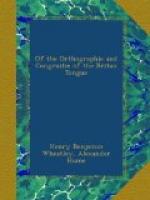P. 11 (8). He objects to the use
of w for u in the diphthongal
sound of ou, and therefore spells
how, now, etc., hou, nou.
P. 11 (10). It is difficult here
to see what the pronunciation of
buu would be, which the author
gives as the sound of bow (to bow).
Probably the sound he meant would be better
represented by boo.
P. 13 (12). The author here recommends the distinction both of sound and symbol of j and v as consonants, and i and u as vowels, and proposes that we should call j jod or je, and v vau or ve, and not single u, “as now they doe” (p. 16), and w he would call wau or we, and moreover he places them in his alphabet on the same page. If this proposal was originally his own, it is curious that the name ve should have been adopted, though not the we for w. Ben Jonson points out the double power of i and v as both consonant and vowel, but he does not attempt to make them into separate letters as Hume does.
P. 15 (12). He gives as an anomaly of the South that while the d is inserted before g in hedge, bridge, etc., it is omitted in age, suage, etc. He does not see that the short vowel requires a double consonant to prevent it from being pronounced long.
P. 21 (6). He disputes the possibility of a final e, separated from a preceding vowel by a consonant, having any effect whatever in altering the sound of the preceding vowel, and recommends the use of a diphthong to express the sound required; as, hoep for hope, fier for fire, bied for bide, befoer for before, maed for made, etc. He uniformly throughout follows this rule.
P. 22 (5). Hume here accents difficultie
on the antepenultimate
instead of the first syllable.
P. 23 (7). He puts down outrage as
an instance of two distinct words
joined by a hyphen, which is the derivation
given by Ash in his
dictionary, in strange obliviousness of
the French word outrage.
P. 27 (1, 6). T is omitted after
s in the second person singular
of the verb, and so no distinction is
made between the second and the
third persons; thus, thou wrytes, and
at p. 32 thou was, and thou hes.
P. 29 (7). The supposition that the
apostrophe ’s as a mark of the
possessive case is a segment of his, a
question which has been lately
revived, is here denied.
P. 34. In this last chapter on Punctuation, which the author styles “of Distinctiones,” no mention whatever is made of the “semicolon,” though it occurs frequently in the MS., as, for instance, p. 30, cap. 6. This stop, according to Herbert, was first used by Richard Grafton in The Byble printed in 1537: it occurs in the Dedication. Henry Denham, an English printer who flourished towards the close of the sixteenth century, was the first to use it with propriety.
P. 34 (6). The explanation of the
mode of pronouncing the comma “with
a short sob” is odd.[5]




